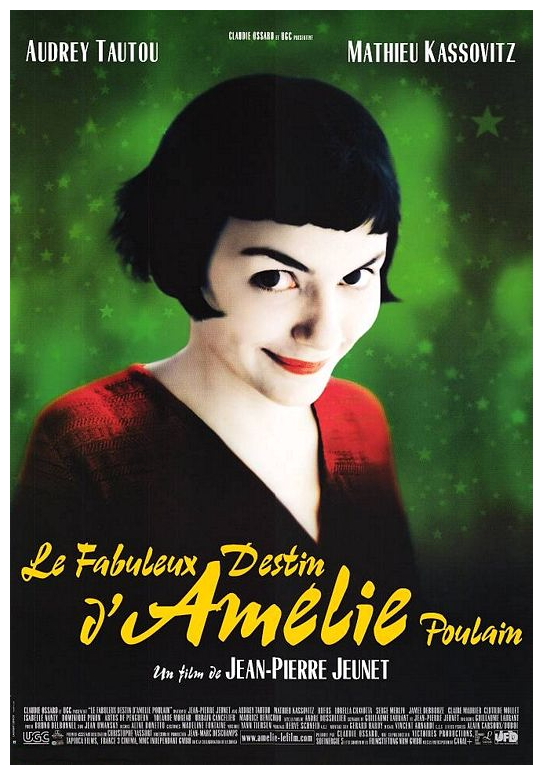
SYNOPSIS:
“Born in an imaginary romanticised version of Paris, Amélie Poulain is the ingenious child of a neurotic and an iceberg. Now that she is working as a waitress, she revels in sneakily intervening in other people’s lives, but her prankish nature makes it hard for her to directly express her feelings for the man she loves. Instead she prepares a scavenger hunt through a fabulous Montmartre.”
REVIEW:
After producing a series of animations and shorts with Marc Caro, filmmaker Jean-Pierre Jeunet first found success with their collaborative debut feature Delicatessen (1991). Its quirky style and dark comedy created a cult appeal that enabled the duo to make The City Of Lost Children (1995), an eerie fairytale for kids of all ages. Hollywood took notice and Jeunet was hired to direct Alien Resurrection (1997). Though a box office success, the experience of working with major studios left him frustrated. More inspired by Marcel Carne‘s prewar Poetic Realism than the aesthetics of the French New Wave, Jeunet’s films are a celebration of imaginative creation. Like his German counterpart Tom Twyker or his American precursor Terry Gilliam, Jeunet delights in cinema’s power to depict anything imaginable, from beating hearts to suicidal goldfish in Amélie (2001) also known as Le Fabuleux Destin d’Amélie Poulain – in fact his iconic heroine mirrors his own magical/realist skills, turning the lives of those around her into dreams come true.
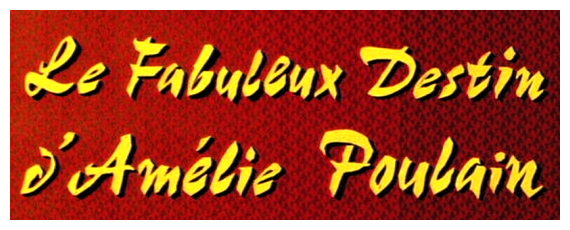
A beautiful young girl named Amélie Poulain (Audrey Tautou) lives mostly in her make-believe world, a far more wonderful and much safer place than reality. Ignored by her cold-fish of a father (Rufus), Amélie loses herself in fanciful projects and willowy escapades, even playing matchmaker for a time with unsuspecting co-workers. Along the way, a caring and concerned father-like neighbour tries to prevent this pretty pixie from making a mess of her life, particularly in her offbeat relationship with a handsome stranger who collects rejected photographs from public photo-booths. Filmed in a vibrant palette of green, yellow and red that recalls the striped roof of a circus tent, Amélie is a movie about the magic to be found in the familiar. So much more than just The Secret Life Of Walter Mitty (1947) with a French accent, Amélie charmingly suggests that fantasy and reality co-exist in all our lives, and need to be balanced correctly for maximum results.

As pointed out by her wise old neighbour (who better than an artist to comprehend such personal truths?), winsome young Amélie is using her vast imagination primarily to run away from life. The result of an ‘iceberg’ father and a ‘neurotic’ mother, this painfully shy creature sublimates with every breath she takes, turning her day-to-day existence into a magical adventure, a clever twisted game, and one that eventually inspires another needy player, Nino (Matheiu Kassovitz). Too shy to tell her own story, Amélie’s tale is recounted by a narrator over a carnivalesque soundtrack and visual representations of our heroine’s emotions, intentions and thoughts. Photos talk, hearts thump so vibrantly with love they shine, statues wink and point the way, an illegally cut key glows in a skirt pocket, and Amélie’s musing about how many couples are having simultaneous orgasms is answered by a brief montage of fifteen climaxing lovers.
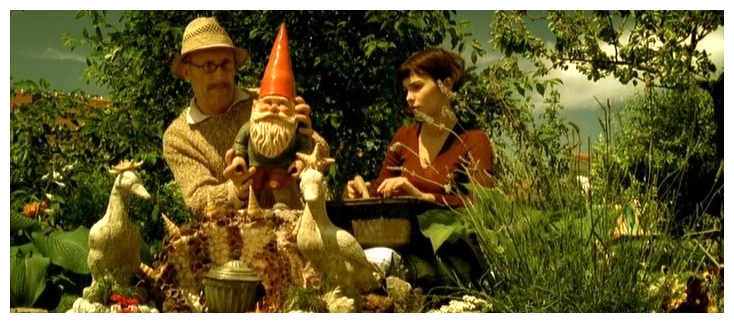
In one of many surreal moments in the film, our heroine watches a television documentary about herself which paints her as the godmother of outcasts, Madonna of the unloved. Interestingly the fantasies on display are not exclusively from our heroine’s imagination. Nino is awakened by jolly living photographs (all of the same guy, and they argue with each other), while heavenly light envelops those fortunate souls aided by Amélie during her ‘do-gooder’ phase (resulting in a brief but significant Zorro impersonation). It’s almost as if life itself has a goodnatured sense of wonder. That’s certainly apparent in the mixed up personal relationships our self-appointed guardian angel giddily sets in motion, most of which gloriously backfire. Not that all of Amélie’s unexpected deeds are blithely benevolent. She uses her puckish brain cells to punish a deserving local bully, and drives her disinterested father bonkers by stealing his beloved gnome, sending it on a round-the-world trip and mailing him the photos. Typical of this film’s sense of bright irony, he is finally inspired to take the trip himself.
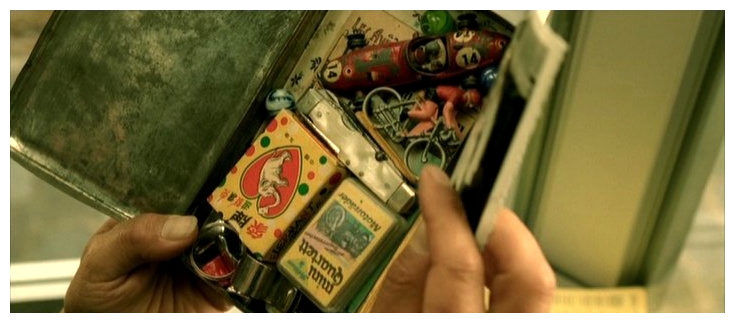
At the centre of this heartwarming and gentle love story is Amélie herself, played with bright-eyed hopefulness and post-adolescent angst by the lovely Audrey Tautou. Whether probing into past lives to return some priceless childhood artefacts or teasing Nino as a provocative ‘Woman Of Mystery’ (always at a semi-safe distance), she is both fetching and painfully vulnerable. After all the animated animals, hidden boxes and glowing keys have served their purpose, we are relieved to see this sweet young woman’s total embrace of a kindred spirit. Cute as a kewpie doll, Tautou’s face was considered adorable enough to carry the entire marketing campaign for Amélie, so it’s no surprise that there’s a special features segment on the DVD dedicated to Tautou’s Funny Faces, basically a bloopers reel of the actress getting those cute funny faces not quite right. More worthwhile is a making-of documentary that is an amusing reminder of how wacky the filmmaking process can be: Tautou is filmed metamorphosing into Amélie; extras are shown having their photos taken in a bona fide booth for Nino’s album; and Jeunet is captured directing the orgasmic montage.
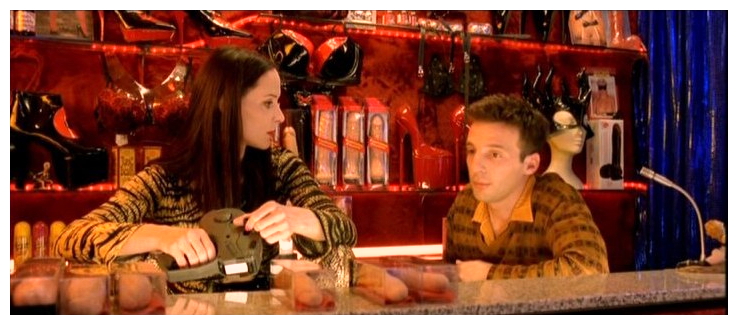
There’s also the somewhat standard storyboards, photo galleries and trailers. Celebrating the magic in life and within ourselves, director Jeunet paints a most pleasing picture indeed. Amélie’s story and its images are cluttered with details and narrative digressions, meandering past subplots that are all resolved by the film’s end. As with all his films, each shot has a unique twist, a strategy that turns his images into visual puzzles. Much brighter than his earlier films, this was Jeunet’s real breakthrough into the mainstream, collecting five Oscar nominations. Right now I’ll ask you to please join me next week when I have another opportunity to force-feed you more unthinkable realities and unbelievable factoids of the darkest days of cinema, exposing the most daring shriek-and-shudder shock sensations to ever be found in the steaming cesspit known as…Horror News! Toodles!
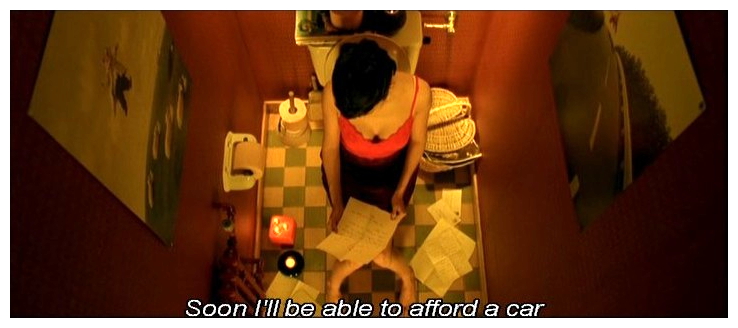
Amélie (2001)
 Horror News | HNN Official Site | Horror Movies,Trailers, Reviews
Horror News | HNN Official Site | Horror Movies,Trailers, Reviews


